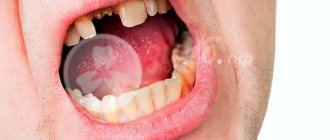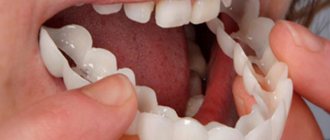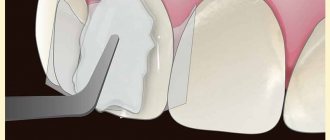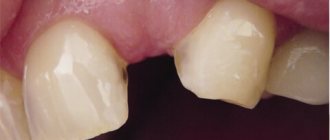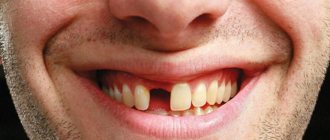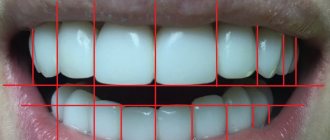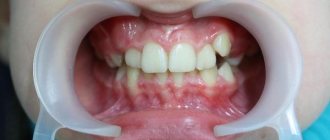Indications and methods for artistic dental restoration
Artistic restoration of teeth
This is a method in which the natural structure of the tooth is restored by copying dental tissues with various materials. Restoration can be carried out to change the position of teeth, to change their color and to eliminate existing defects.
Video example of restoration of anterior teeth (incisors) with composite material (eng)
Video of restoration of the upper canine with composite material (eng)
Dental restoration is a treatment whose indications are the presence of caries, any non-carious lesion of the tooth (fluorosis, enamel erosion, abrasion of the surface of the teeth, etc.), chips and cracks, gaps between teeth, enamel pigmentation, as well as incorrect positioning of teeth in dentition. At the moment, there are direct and indirect methods of dental restoration. Which method will be used depends on the problem that needs to be fixed and your wishes.
Direct dental restoration
It is performed directly in the dentist’s chair using special restoration materials. The convenience of this method lies in the fact that in one visit to the doctor you can solve your problem and enjoy a beautiful smile. However, there are cases when indirect dental restoration may be necessary; the prices for dental services in this case will be significantly higher than for direct restoration. This restoration method involves the production of thin porcelain or composite plates - veneers.
Indirect dental restoration
Now it is accepted as very high quality, since it requires making the most accurate shape of the material for your tooth in the laboratory. Due to this, such similarity with natural dental tissues is achieved.
Dental restoration techniques are used differently depending on the chosen restoration method. They differ in that with the indirect method, this technique takes place in several stages. With the indirect method, two visits to the doctor are required, taking an impression, installing a temporary filling, fitting, and only then installing the restoration material.
Our specialists will select the most suitable restoration method for your specific case and answer all questions that may arise. Teeth restoration before and after photos will show you what effect our doctors achieve.
Indications
Most often, patients resort to artistic restoration of teeth in order to improve, first of all, their aesthetic appearance. But at the same time, you need to understand that the procedure pursues another main goal, namely to restore the tooth completely, returning functionality.
Let's consider the indications for artistic restoration:
- large gaps between teeth;
- the presence of irregularities in the dentition;
- presence of chips on the front teeth;
- severe wear of the teeth.
What materials are used for dental restoration?
Dental restoration is the restoration of a chipped, broken or partially destroyed tooth by caries or in some other way. The materials used for dental restoration depend on which method was chosen. For direct restoration, the dentist uses composite materials (photopolymers); indirect restoration is longer and more expensive, because this method requires time to make a veneer from ceramic mass.
Dental restoration with composite materials has many adherents around the world. The development of aesthetic dentistry allows the use of the latest restoration materials, which helps patients not be embarrassed about their smile after just a couple of visits to the doctor. Photopolymers, which have found their application in the restoration process, are very convenient to work with, because they very easily take the desired shape. Composite dental restoration allows you to change the color of a tooth, restore and change its shape, and close the gaps between teeth.
Prices for dental restoration using photopolymer composite will depend mainly on the degree of damage to the tooth, the chosen treatment method and the composite material used. Dental restoration using filling material is in many ways inferior to restoration using veneers. Over time, this material may darken, lose its shine, and if the tooth is severely damaged, such a restoration can be destroyed under the influence of external factors.
Stages of restoration with veneers
Indirect restoration is carried out according to the following scheme:
- Determining the shade of the material used to make the veneer.
- Preparation of the dental organ to a thickness of 0.5 - 1.5 millimeters, depending on the destruction.
- Taking an impression.
- Attaching a temporary plastic veneer to the prepared part of the front tooth. This way the tooth is protected from external influences while a permanent veneer is being made.
- Making veneers in the laboratory. First, a model is made from plaster, from which the product is made using different methods. You can even draw microcracks on it, which will give the tooth a natural appearance.
Sequence of the dental restoration process
There is a certain sequence in which the restoration procedure is carried out. This methodology must not be violated, otherwise you will not get the desired result. So, the stages of dental restoration:
- Preparation for the restoration procedure. The tooth surface is mechanically cleaned, anesthesia is applied if necessary, and the tooth is isolated from saliva using a rubber dam.
- Tooth preparation. Removing pigmented enamel, softened dentin and cleaning teeth from caries.
- Gasket application. It is necessary to protect the pulp from possible exposure to the composite.
- Etching dentin and enamel. It is necessary for the sterility of the surface of the cavity and promotes better adhesion of the hard tissues of the tooth to the composite.
- Applying primer to the surfaces of enamel and dentin. Makes dentin airtight, thereby limiting it from any external influences due to clogging of dentinal tubules.
- Application of composite and its plastic modeling.
- Composite polymerization. Hardening of the composite material.
- Final processing of the restoration. The surface is modeled and formed after restoration.
- Carrying out control tests and correction of restoration work.
- Surface polishing.
- Final polymerization.
Dental restoration using photopolymer composites: stages of the process
Before moving on to the restoration of damaged teeth or units with poor aesthetics, the doctor will definitely conduct a thorough examination of the oral cavity for the presence of dental diseases. Next, the restoration process will be divided into the following stages:
Professional sanitation of the oral cavity
At this stage, the teeth are cleaned of all types of plaque - hard and soft, tartar. Sanitation of the oral cavity is necessary to accurately determine the shade of natural tooth enamel. Based on a certain shade, the dentist will choose the tone of the composite material, which will allow you to obtain the most aesthetic result of dental restoration.
Anesthesia of the restoration area
It is carried out using local anesthetics. Anesthesia is not always necessary, but only in cases where the tooth is severely damaged by caries. The anesthetic is selected individually and allows for tooth restoration without the slightest discomfort for the patient.
Removal of tissues damaged by caries and old fillings
Before carrying out the restoration, the doctor must properly treat the tooth: remove all tissue destroyed by pathological processes, old and unusable fillings.
Moisture insulation is the most important stage in tooth restoration
In order for a tooth restoration to be not only aesthetically pleasing, but also durable, the area where the manipulation is performed must be properly protected not only from saliva, but even from moisture contained in the patient’s breath.
Cotton swabs were previously used for this purpose, but they did not provide reliable moisture protection. In modern clinics, a special latex lining, a rubber dam, is used to perform moisture insulation. Externally, this pad looks like a handkerchief with slits. The rubber dam is tightly stretched over the teeth and prevents moisture in one form or another from entering the area of restoration work. It is advisable that in the process of dental restoration, a specialist uses a rubber dam, since insufficient protection of the restored tooth from moisture is fraught with a number of negative consequences:
- The edges of the photopolymer filling will not adhere to the natural tissues of the tooth with sufficient density, and this is fraught with the formation of a noticeable dark stripe at the border of their contact or the development of caries in this area;
- An installed filling can quickly fall out, since moisture reduces the degree of adhesion (adhesion) of the photopolymer and dentin.
Installation of a pin in the dental canal
A pin is not always installed during dental restoration, but only when a dental unit is destroyed by more than fifty percent and is depulped. Installing a pin allows you to make the restoration as strong as possible and avoid the filling falling out.
Tooth restoration
At the final stage of the treatment process, the doctor performs the actual restoration, that is, restores the shape and aesthetics of the tooth with photopolymer filling material. The restoration is carried out layer by layer and photopolymers of different shades and transparency levels can be used to create layers - this is necessary so that the result of the restoration work has high aesthetics. The restoration is completed by processing the filling with burs, grinding it and sealing it.
Alternative restoration
Restoration of the tooth crown
Can be produced in various ways. Our clinic offers them all. This can be traditional dental filling, covering the tooth surface with veneers, restoring the anatomical shape of the tooth using a crown, or any existing method of prosthetics (implants, inlays, etc.). The main task of the dentist is to choose and offer the patient the most optimal method of tooth restoration.
Dental restoration with veneers
This method will be acceptable in the following cases:
- treatment of chipped teeth;
- getting rid of a small gap between the front teeth;
- changes in enamel color that cannot be bleached in any other way;
- changes in the shape of the tooth crown;
- changes in moderate curvature of teeth.
Dental restoration with inlays
It is used for minor tooth damage, when restoration of 1-2 sides is necessary. There are restorative (restore the shape and color of the tooth) and stump (a crown is then placed on top of them) inlays. Inlays can be made of metal, ceramics, metal-ceramics, as well as composite and all-ceramic.
If your tooth is more than half destroyed, and even more so if the nerve in it has also been removed, then it is recommended to install a crown. They are ceramic and metal-ceramic. Service life, aesthetics and reliability are superior to conventional restoration methods.
Indications for installation of veneers
- The presence of diastemas (gaps between the front teeth);
- chips, cracks, depressions, stains on the enamel;
- discoloration of teeth as a result of medical or dental treatment;
- single teeth protruding from a row;
- small, irregularly shaped teeth;
- slightly crooked teeth;
- gummy smile.
Veneers can correct the bite in the sense that in some cases, the onlays lift the bite, thus helping to bring back the “gone” lower jaw. This prevents problems with the temporomandibular joint and improves the quality of life.
To correct malocclusion, orthodontic treatment with braces or aligners (aligners) is necessary.
Contraindications for dental restoration procedures
- The patient has an incorrect bite.
- Absence of a certain number of chewing teeth.
- The presence of a disease - bruxism.
- Monolithic destruction of the inner enamel of the tooth.
- Unnatural tooth wear.
- Passion for dangerous sports (for example, boxing).
However, some indications can be treated, so the possibility of restoration should not be abandoned forever. You can cope with bruxism or correct a malocclusion and then contact us for dental restoration.
Aesthetic restoration of teeth: indications, methods, stages
Doctor - dentist-therapist, microscopist
Aesthetic restoration of teeth in dentistry is a method of restoring their natural structure using various synthetic materials. This procedure also allows you to return your teeth to their original appearance and functionality. Composite filling materials and veneers are used for restoration. This procedure is also known as artistic or cosmetic restoration.
Why is tooth stump restoration necessary?
Tooth stump restoration is used in dentistry to restore a badly damaged tooth to a degree that allows the tooth to be prepared for installation of an artificial crown. Recently, dentists have been actively using the direct method of restoring the tooth stump (pinless method), which uses special composite materials. Very often, when a tooth is severely damaged, only the root remains and for greater support, it is necessary to install a pin (pin method). The mouth of the canal is widened, treated, filled, and only after that can a pin be installed.
There is also another way to restore a tooth stump - a cast stump inlay. This is a custom made metal post that restores the portion of the tooth above the gum. This is a monolithic alloy that has no seams or joints, which gives it greater strength and resistance to heavy loads.
Disadvantages of restoration
- the ability of light polymers to gradually lose shine and darken. In this case, such a composite will have to be changed every few years;
- the possibility of breaks and chips of the material when the tooth is destroyed by more than half. This situation is even more often found in teeth with a removed nerve and in patients who often eat solid foods. Breakages of restored teeth are often observed in cases where restoration took place from the very root. If the chewing load is exceeded, such a dental organ can easily break. There are often cases when the tooth root also breaks, in which case the tooth can only be removed.
Artistic restoration of anterior teeth
Dental restoration in Moscow today is available to everyone, and it is especially important for that part of the teeth that we show to others. Artistic restoration of the front teeth requires good skills from the dentist not only from a medical, but also from an aesthetic point of view. This type of restoration is the most popular because people want to smile without embarrassment. Restoration of the anterior group of teeth by specialists at our clinic today is able to correct any tooth defects from chips and cracks to giving the natural color of tooth enamel.
There are direct and indirect restoration of anterior teeth. Only consultation with a specialist can help you choose one of these methods. In the first case, reflective filling materials are used. This process is based on layer-by-layer application of photopolymer material, which requires the skill and experience of a doctor. This method can be used for minor damage to the tooth, as it is subject to abrasion over time. Restoration of the frontal group of teeth, when choosing an indirect method, is based on the work of the doctor, which consists of observing several rules:
- correct selection of the color of the desired material for the veneer;
- using the correct tooth preparation technique;
- taking impressions of the front teeth;
- installation of temporary and then permanent veneer.
Restoring the front teeth with veneers will be appropriate if, after some dental procedures, it is no longer possible to achieve color by whitening. They can also be used to slightly correct the shape of your teeth. Depending on the manufacturing method and material, veneers are divided into therapeutic ones made of composite material and orthopedic ones made of ceramics. Only a qualified dentist can tell you which type you need. The effect obtained from this method of restoration can be seen in the photo before and after restoring teeth with veneers.
Few people think about the fact that when we talk or laugh, the lower part of the teeth is always visible. Therefore, restoration of the lower teeth is extremely important and simply necessary for a healthy and beautiful smile. Also, a very large load is placed on the lower row of chewing teeth, which contributes to the frequent formation of chips and caries. Therefore, you need to understand that artistic restoration of chewing teeth is important not only from a practical, but also from an aesthetic point of view.
Aesthetic restoration of the front teeth from below and above is necessary, first of all, for people who have problems with their teeth, but want to be self-confident and not be afraid of communicating with other people.
Methods
The method used to restore a tooth depends on its condition. There are direct and indirect restorations. Let's look at the features of each:
- The direct method uses photopolymers, that is, composite materials that can reflect light. The dentist-therapist performs extensions using these materials. This is the so-called artistic restoration.
- The indirect method is carried out through the installation of veneers and resembles prosthetics. This type of restoration is performed by an orthopedic dentist. He prepares the tooth, takes an impression, which is used to make a ceramic veneer, which is then installed on the tooth.
Direct restoration
Restoration of anterior teeth using the direct method is usually carried out for minor defects.
Teeth are built up according to the following scheme:
- Preparing the teeth, cleaning them with polishing paste and nylon brushes. From a special scale, the desired shade of the composite is selected, matching the color of the dental organ that needs to be restored. Anesthesia is also administered.
- Next, the tooth is prepared, removing tissue that has been affected by caries. When repeating restoration, the previously supplied composite is removed. Preparation is carried out using gentle technology in order to preserve the healthy parts of the tooth as much as possible.
- Then you need to isolate the tooth from moisture. It is important that saliva does not get on it, which negatively affects the condition of the reflective polymers. For this purpose, cotton balls and rollers are used. In addition, the front teeth can be protected from moisture thanks to the rubber dam used.
- If the tooth is severely damaged, a pin may be installed in it.
- Next, the dental crown is modeled through layer-by-layer application of the composite.
- Finally, the shape of the restored dental unit is finally modeled with a bur, the surface is ground and polished.
Indirect method
In case of indirect restoration, veneers are attached to the tooth surface (on one side). This way the surface and shape of the tooth can become ideal. In this case, the doctor does not need to painstakingly work on each tooth cusp.
While direct restoration has no contraindications, the indirect method has them.
Let's consider the main ones:
- malocclusion;
- destruction of the tooth crown by more than half;
- fillings on the lingual side of the dental organ that needs to be restored or severe destruction of its back part;
- bruxism;
- the presence of pathological abrasion of teeth;
- bad habits such as opening bottles with teeth, biting off threads, and so on;
- if the tooth was subjected to resorcinol-formalin treatment;
- a lifestyle that may expose your teeth to ongoing trauma, such as boxing;
- when restoring one or a group of chewing teeth.
Alternative methods to composite materials
- Ceramic veneers can be used when a tooth is damaged only on the visible side, when the back side has minor damage. The ceramic composition does not darken over time and does not lose its shine. The main disadvantage of using this alternative to composite material is the high cost.
- Ceramic or metal-ceramic crowns are used when the tooth is severely damaged, more than half of it. If the tooth is also dipulped, artistic restoration will definitely not help here. At the same time, a complete tooth restoration costs about the same as a metal-ceramic crown. And the service life, aesthetics and reliability of the crown are much higher.
- Inlays are good to use when restoring a lateral chewing tooth. Their service life and reliability are much higher than that of composites. If you use a ceramic inlay rather than a metal one, then the aesthetics will be superior to the use of composites.
Restoration of the chewing group of teeth
The main goal pursued during the restoration of lateral teeth is the restoration of their functionality, that is, the restoration of chewing function. Restoration of lateral crooked teeth is necessary for several reasons.
Firstly, excessive curvature of the teeth can tear the gums, thereby causing discomfort and pain when eating.
Secondly, an incorrect bite can lead to incorrect redistribution of the load on the teeth.
Third, wide and flat surfaces will cause severe tooth wear and reduce chewing efficiency.
All these factors can negatively affect the general condition of all teeth. Therefore, during restoration, reproduction of the individual characteristics of the tooth, including macrorelief, all tubercles and pits, plays a very important role. You should monitor the health of all teeth without exception, not paying attention only to those that are visible when you smile.
Reviews
Patients who have had their front teeth restored often complain that the shape and color of the tooth are not what they would like to see. That is, the main claims relate to the aesthetic result. It is important to carry out restoration taking into account all the rules. For example, if you ignore transparency, the filling will be clearly visible on the tooth.
But most patients are still satisfied with the result of the procedure. Let's look at a few reviews.
Marina, 31 years old
After I had an accident, I was very embarrassed about my teeth, since there were significant chips on the visible part. The doctor advised to make a restoration. I’m happy with the result, now I don’t have to cover my mouth with my hand when talking. The smile is almost perfect.
Ekaterina, 29 years old
I had crooked front teeth, which caused a lot of inconvenience. I still couldn’t decide on braces, so the dentist recommended getting veneers. After them, the smile changed beyond recognition. True, the doctor said that they most likely will not last for a long time, since my bite is incorrect, but I hope to wear them for as long as possible. I carefully follow all the doctor’s recommendations.
Nikolay, 26 years old
After straightening the teeth with braces, caries stains appeared on the enamel. They did an artistic restoration. So far everything is fine. Those places where photopolymer extensions were applied are not at all different from teeth.
Restoration of baby teeth in children
Today, even a child can have a tooth restored in our clinic. Restoration of a baby tooth is necessary in case of injury or extensive carious destruction. This method allows you to completely restore the anatomy of the crown of a baby tooth, which will allow you to preserve it until it is naturally removed and replaced with a permanent tooth. Do you think saving a baby tooth makes no sense?
You are wrong, because the health and well-being of baby teeth has a direct impact on the condition of permanent teeth. Plus, a baby tooth that falls out unnaturally can cause deformation of the dentition. After all, if the permanent tooth has not pushed it out, but the gums are empty and the neighboring teeth may begin to move. In addition, premature tooth loss can lead to deterioration of diction, changes in bite, increased load on neighboring teeth, which can also fall out prematurely and many other negative consequences. Thus, we come to the conclusion that the need for restoration of temporary teeth should not be ignored by parents. Timely intervention by a dentist in the problem will help avoid complications in the future.
Complete restoration of the tooth crown
The cost of restoration will be based on the cost of the following consumables and services:
- Preliminary anesthesia - about 450 rubles;
- Moisture insulation with rubber dam - about 700 rubles;
- Photopolymer filling - from 2000 to 5000 rubles (depending on the type of composite, manufacturer’s brand, amount of material needed for restoration;
- Cost of the pin. Pins are produced by different brands and it is better not to save money and choose a more expensive, but at the same time the highest quality product. Prices for heavy-duty fiberglass pins used in restoration start at 2,500 rubles.
USEFUL TO KNOW: Pins are made from different materials, including metal structures. But it is not advisable to use metal pins for restoration carried out in the area of the anterior teeth. The metal will show through the photopolymer filling material and as a result the restored tooth may have an unnatural bluish tint.
By adding up the amounts indicated above, you can calculate the approximate cost of restoring the entire crown part of the tooth. Such a restoration will cost the patient 6,000-7,000 rubles. Please keep in mind that the stated restoration price does not include the cost of preliminary professional teeth cleaning!
Partial restoration of the tooth crown (no more than ½)
To calculate the cost of restoring a tooth that is half destroyed, it is worth subtracting from the amount calculated above the cost of the pin, which is placed to make the filling resistant to mechanical stress. Thus, the price for partial restoration of a tooth crown will be 5,000 rubles.
Restoration of chipped teeth
Restoration of chipped teeth has a minimal price, which is not surprising - the cost of the service excludes the price of the pin, in addition, the consumption of filling material will be significantly lower. Such restoration is offered to dental patients at a price of 2,500 to 3,000 rubles.
Aesthetics in dentistry
In our society, a beautiful snow-white smile has already become not just a sign of health and well-being, it is good manners. That is why cosmetic dental restoration in Moscow is now so popular. Now it is customary to sparkle with the whiteness of your perfectly straight teeth and even decorate them with precious stones.
Aesthetic dental restoration involves giving the ideal appearance of the tooth, its color, shape and structure. In the hands of a professional dentist, restorative materials transform teeth into works of art. Since modern aesthetic restoration implies the complete elimination of any changes and defects on the surface of the tooth. This is exactly the kind of modern dental restoration on Vernadsky Avenue (Yugo-Zapadnaya metro station) that is available to everyone. Our clinic’s specialists will advise you and tell you what types and how restoration of tooth color, enamel and shape occurs. They will advise you on prices and explain what results you should expect from each specific restoration method.
In order to achieve a beautiful shape and durable dental covering, our dentistry uses high-quality composite materials. These materials come in a huge variety of colors to give the teeth a natural appearance and similarity to the patient's other teeth. Restoring the shape of teeth allows them to return their functionality, as well as make the size of the teeth more suitable to each other from an aesthetic point of view.
Aesthetic restoration of anterior teeth is designed to give a natural shape to the tooth line. It is known that teeth darken with age, and teeth with a removed nerve also have this unpleasant property. The color of enamel is negatively affected by eating foods that have coloring properties, as well as smoking. In modern dentistry, there are many teeth whitening systems. Restoration of tooth enamel can be carried out using any of them or by applying special lumineers and veneers.
You can contact our clinic and get all the information you are interested in about how artistic dental restoration works. Our prices are quite reasonable, and the quality of the services provided makes you come back to us again and again.
Aesthetic dental restoration video shows how the procedure takes place in the clinic.
Dental restoration: a service you shouldn’t skimp on!
The quality of the dental restoration will determine its aesthetics and durability. You can often find reviews online from patients who were dissatisfied with the poor aesthetics of the restoration: the installed filling is clearly visible and the tooth looks unnatural compared to its healthy “neighbors.” The reason for poor aesthetics is the lack of professionalism and experience of the dentist, as well as violation of the rules of restoration.
For high aesthetics of the result of dental restoration, the following three points are of fundamental importance:
1. Correct restoration of the natural shape of the tooth. This is quite complex and painstaking work, requiring from the dentist not only knowledge and experience, but also artistic talent. When working on the restoration of the form, the specialist must accurately recreate the natural fissures, cusps, and surface of the tooth;
2. Accuracy of tooth-colored restoration. The restored tooth should have a color identical to the tone of the adjacent, healthy units in the rows. Photopolymers for fillings are available in a wide variety of shades, and the specialist’s task is not only to choose the optimal color, but also to be able to combine various tones so that the restored dental unit looks as natural as possible. Not every dentist knows how to work with color and, in addition, some specialists do not take into account the fact that the shade of tooth enamel changes from the edge to the neck. If this important point is overlooked during restoration, the restored tooth will stand out against the background of its “neighbors”;
3. Account for transparency. Not only the tone of the tooth enamel changes, but also the degree of its transparency. It is higher at the edge, and therefore, to restore a tooth in this area, it is important to choose a material with the highest possible transparency.
Now you know why, to obtain aesthetic results from dental restoration, you should contact a dental clinic staffed by experienced and competent specialists. Naturally, the price of restoration in such a clinic will be higher, but the result will not make you want to write a negative review! A full range of dental restoration services is offered to you by our dentistry in Moscow - Vanstom (located next to the Baumanskaya metro station)! You can make an appointment at our clinic either by phone or through the feedback form on our website.
The best material for teeth is ceramics
Ceramics have been used in dentistry for many years and are very successful. Dental restoration with ceramics is the best way to achieve an invisible and high-quality result. Dental restoration of teeth requires not only the correction of teeth from an aesthetic point of view, but also the elimination of more serious defects. Crowns, veneers, lumineers, bridges, etc. are made from this material.
Lumineers are made from high-strength pressed ceramic. They are resistant to mechanical damage, look very natural and are durable. This is an ideal replacement for regular teeth whitening.
Ceramics also have another very important quality - a wide range of colors. Choosing the right color is not difficult, since the choice is large, you can find all natural shades of teeth.
Now you have access to high-quality ceramic dental restoration at Yugo-Zapadnaya. To do this, you must come to us, here you will be pleased not only with the quality of the services provided and the professionalism of the staff, but also with the cost. Tooth restoration in Moscow at the ARTOX clinic is fast, high-quality and inexpensive .
Our specialists know first-hand what dental restoration is. You can find reviews about all restoration methods on the Internet, but you should not completely trust them. Only professional diagnostics and consultation with a doctor, a specialist in this field of dentistry, can provide you with a complete picture of the treatment and tell you how justified a particular restoration method is. The main thing is to be sure who you trust with your health.
And don't forget that regular visits to the dentist and good oral hygiene will help you prevent many dental problems. Well, if they do arise, then you must immediately seek qualified medical help in order to avoid complications. Our clinic is always ready to come to your rescue and provide quality treatment at affordable prices.
Pros and cons of veneering
Dental overlays for correcting malocclusion not only make your smile attractive, they increase self-esteem and improve your psychological state.
Advantages of veneers:
- Short installation times
. Composite onlays require 1 appointment, and ceramic onlays require 2-3. - Exact imitation of enamel
. The ability to transmit light makes ceramics indistinguishable from natural teeth - Biological inertia
. Allergy is not a contraindication. - Resistant to pigments and dyes
. Unlike natural teeth, ceramics do not change color over time. - Durability
. Ceramic compounds are several times stronger than composite ones. - Wear resistance
. If the recommendations are followed, ceramic linings last up to 20-25 years. Plates are replaced more often because the cement (adhesive) that attaches them to the teeth wears out.
97%
[1] Veneers are functioning perfectly 7 years after installation.
83%
[2] – after 20 years.
Several factors influence the lifespan of veneers:
- doctor's qualifications;
- mastery of technique;
- compliance with manufacturing and fixation technology;
- quality of materials;
- patient compliance with recommendations.
Therefore, it is recommended to choose large clinics with their own dental laboratories. The dentist and technician work together in such centers, discuss problems and find the best ways to solve them. The third member of the team is the patient.
It must be remembered that no veneer, even the most durable, can resist cracking nuts or biting wire. But curvature can be corrected with plates in a high-quality and long-term manner only if the recommendations are followed.
Disadvantages of veneers:
- The need for tooth preparation. Once you install veneers, you won’t be able to refuse them.
- High price. However, in the long term, ceramic veneers pay off. They do not need to be regularly polished and replaced with new ones.
Restorations
Artistic restoration of central teeth
The work was performed by a doctor: Denk Tatyana Vladimirovna Patient (22 years old). Artistic restoration of central teeth. Complaint: chipped front teeth 2.1. and 1.1. Treatment: restoration of the front teeth 1.1. and 2.1. using Estelite restoration material.
Restoring aesthetics and dental function with E-max veneers
The work was performed by a doctor: Zavorotny Roman Vyacheslavovich Patient, 35 years old. Complaints about aesthetic dissatisfaction. The medical history revealed the cause: excessive consumption of carbonated drinks. A joint decision was made to restore the aesthetics and function of teeth using E-max veneers. Result before and after treatment. The difference is two weeks.
Artistic restoration of the central tooth
Artistic restoration of tooth 46
The work was performed by a doctor: Zavorotny Roman Vyacheslavovich Patient I., 45 years old.
Complaints: An old filling in a chewing tooth in the lower jaw fell out.
Diagnosis: Secondary caries of the 46th tooth.
Treatment: mechanical treatment of the carious cavity, removal of the remains of the old failed filling, artistic restoration of the 46th tooth. The aesthetic and functional features of the chewing tooth have been restored. The work lasted no more than 60 minutes.
Closing diastema between teeth with ceramic veneers
The work was performed by a doctor: Admin Patient A., 40 years old.
Complaints: the patient requested to close the diastema between the central front teeth of the upper jaw. Her old dream.
Before working directly with the teeth, impressions were taken, and then diagnostic models were cast from plaster. A dental ceramist created a possible version of a future ceramic restoration using wax.
After discussing with the patient the shape and size of the presented wax composition, a number of changes were made and temporary plastic veneers were made from them, which were installed immediately after tooth preparation.
Then the patient was given the opportunity for a week to take a closer look at the temporary veneers, their shape and size, since immediately after their installation it is difficult to make decisions, it is necessary to get used to them, and consult with loved ones if necessary.
A week later, at a follow-up meeting, more minor changes were made.
Only after all possible modifications to the plastic veneers, having received the “go-ahead” from the customer, did the ceramist technician begin to create ceramic veneers using metal-free ceramics e.Max from Ivoklar, Germany.
Artistic restoration of central teeth
The work was performed by the doctor: Zavorotny Roman Vyacheslavovich Patient L., 35 years old.
Diagnosis: Deep caries of 11, 21 teeth.
Treatment: mechanical treatment of carious cavities was performed, the aesthetic defect of teeth 11 and 21 was eliminated using artistic restoration. The functional features of the central teeth have been restored. The work was carried out in one visit, up to 60 minutes.
Restoration of anterior teeth
Restoration of anterior teeth is an actively developing area of dentistry. In modern conditions, it is possible to improve the aesthetics of teeth in this area by stratification, layer-by-layer application of composite to the defect area, and also by installing special ceramic onlays. Veneering the front surface of a tooth with light-curing materials allows you to get results in one visit, and is a completely affordable procedure financially.
Installing ceramic onlays is a more complex method than nanocomposite veneering. Such microprostheses, veneers and lumineers, made in the form of plates fixed to the front surface of the teeth, will provide the most advantageous and long-term results. However, to significantly improve aesthetics, computer technology must be used, which increases the cost of the procedure.
To help dentists, there is also a restoration technique carried out using a silicone key.
Indications for restoration
Restoration of the frontal group is necessary for patients who are concerned about:
- destruction of dental tissue caused by caries;
- erasing the enamel of the tooth and its necks;
- defects in the shape of the tooth and its location in the oral cavity;
- change in enamel color;
- damaged tooth integrity (chip or loss).
Contraindications for restoration of anterior teeth
The procedure for restoring the frontal group of teeth should be carried out especially carefully if:
- you performed resorcinol-formalin treatment on a currently damaged tooth;
- you have a malocclusion;
- the acid-base balance is disturbed, due to which the composite quickly wears off;
- a certain number of chewing teeth are missing;
- you engage in strength sports (boxing, wrestling, weightlifting);
- the tooth is destroyed from the inside;
- a filling was installed in the tongue area.
The process of restoration of anterior teeth
The practice of modern dentists shows that teeth can be completely restored in several stages.
- The basis for restoration work is being created. An X-ray of the tooth is taken and a video of future work is shown. The specialist then treats the damaged area and applies several layers of composite.
- The future form is modeled. The material for the contour of the frontal tooth is applied from below the crown. Once it has hardened, the dentist forms the shape of the crown.
- Individual dental parameters are reproduced. The aesthetic side of such work is very important - creating the contour of the tooth, its edge and macrorelief. The procedure is carried out using an enamel composite, which is applied in excess and sanded.
This technology is relevant for direct restoration, when it is necessary to correct not only tooth trauma, but also eliminate its curvature. The indirect method involves the installation and fixation of veneers.
Modern dental restoration
These days, aesthetic dentistry offers many options for eliminating defects and damage to the front teeth. Thus, patients have the opportunity to see the final result even before the procedure. A computer model of your new smile, a video of which will be demonstrated by the dentist, will allow you to verify the effectiveness of the restoration.

